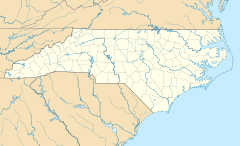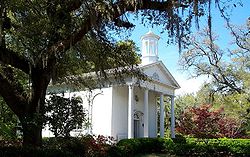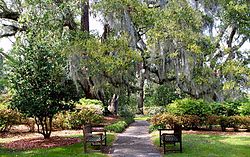- Orton Plantation
-
Orton Plantation
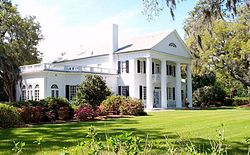 Orton House
Orton HouseLocation: Smithville Township
North Carolina
United StatesCoordinates: 34°3′38″N 77°56′47″W / 34.06056°N 77.94639°WCoordinates: 34°3′38″N 77°56′47″W / 34.06056°N 77.94639°W Built: 1735 Architect: Unknown Architectural style: Classical Revival
Greek RevivalGoverning body: Private NRHP Reference#: 73001294[1] Added to NRHP: April 11, 1973 The Orton Plantation is a historic Southern plantation in the Smithville Township of Brunswick County, North Carolina, United States. Located beside the Cape Fear River between Wilmington and Southport, Orton Plantation is considered to be a near-perfect example of Southern antebellum architecture. Built in 1735 by the co-founder of Brunswick Town, the Orton Plantation house is one of the oldest structures in Brunswick County. During its history Orton Plantation has been attacked by Native Americans, used as a military hospital, and been home to lawyers, physicians, military leaders, and a Colonial governor.[2][3] Although the home is privately owned and closed to the public, the Orton Plantation Gardens and family-owned chapel have become a tourist destination in Southeastern North Carolina, attracting thousands of visitors each year. On April 11, 1973, the Orton Plantation was added to the National Register of Historic Places.
Contents
History
See also: History of North CarolinaIn 1725, Roger Moore, son of Governor James Moore and grandson of Irish nobleman Rory Moore, and his family moved from the Province of South Carolina to an area of land known as Orton in southeastern North Carolina. Orton was owned by Roger's brother, Colonel Maurice Moore, a colonial governor, author of a famous essay denouncing the Stamp Act of 1765, and father of Supreme Court Associate Justice Alfred Moore. Maurice sold the land to his brother when Roger moved to the area and together they founded Brunswick Town one mile (1.6 km) south of Orton.[2][4][5]
The first home Roger built in 1725 was destroyed by local Native Americans. Roger constructed the current Orton Plantation home in 1735 and developed his land into a leading rice plantation with the help of hundreds of slaves. Orton remained in the Moore family until it was purchased by Benjamin Smith, who eventually lost ownership and was forced to auction off the home and surrounding 4,975 acres (2,013 ha). The property was purchased by a physician, Frederick Jones Hill, in 1826. The Orton Plantation remained in Hill's possession until the fall of Fort Anderson and Fort Fisher during the Civil War. Following the Confederate defeat at Fort Fisher, Union soldiers confiscated Orton Plantation and used the home as a military hospital, thus sparing it from destruction. Orton Plantation was abandoned after the War and the house sat empty for 19 years.[2][5][6]
In 1884, Orton Plantation was purchased by a former Confederate military officer, Kenneth MacKenzie Murchison. Muchison restored the plantation to its original appearance and made it his winter home. When Mutchison died in 1904, Orton Plantation was purchased by his son-in-law and daughter, James and Luola Sprunt. James, a lawyer, encouraged his wife to remodel the home and in 1910 he and Luola began the development of a flower garden and expansion of the house. The Sprunts constructed a family chapel in 1915, and when his wife died the following year from scarlet fever, James renamed the building to Luola's Chapel in her honor.[2][5] At approximately the same time their son, James Laurence Sprunt tragically lost his first wife, Amoret Cameron Price giving birth to their first son, James Laurence Sprunt Jr.
In the 1930s, James Laurence Sprunt and his second wife Annie enlarged the garden to its current size of 20 acres (8.1 ha). After a relative was involved in an automobile accident, the Sprunts opened their garden to the public in hopes of raising money for medical expenses. Charging 25 cents for an entrance fee, the family raised $1,000 in a week. From that point on, the Sprunts decided to keep the garden open to the public. In 1954, the Sprunt family donated 114.5 acres (46.3 ha) of the Orton Plantation to establish the Brunswick Town State Historic Site. Four years later, James Laurence Sprunt wrote a book about the history of Orton Plantation entitled The Story of Orton Plantation. After the death of Laurence Sprunt in 1973 and Annie Gray Sprunt in 1978, the ownership was shared by their four sons: James Laurence Sprunt Jr.,Kenneth Murchison, Samuel Nash, and Laurence Gray Sprunt. Kenneth succeeded Bragaw as manager of the gardens after World War II until 2006 when Laurence bought the gardens from his brothers and continued the management. Ownership of the Orton Plantation was passed down to each generation of the Sprunt family for 126 years.
The Laurence Sprunt family sold Orton Plantation in May 2010 to Louis Moore Bacon, a hedge fund manager and direct descendant of Roger Moore, builder of the original Orton home in 1725. Bacon plans to restore the house and renovate the grounds.[2][3][5][7]
The Orton Plantation used to be a tourist attraction with the gardens and chapel open to the public. The old rice fields are now a wildlife sanctuary and the plantation was e a haven for birdwatchers. Weddings, family reunions, corporate events, and school fieldtrips took place at the property and the gift shop and ticket office were located in Sunnyside, a playhouse built in the 1890s for James and Luola's daughter, Marion. Sunnyside was moved to the Orton Plantation in 1939.[5][8] The Orton Plantation website recently announced the gardens are closed indefinitely from June 1, 2010.
Architecture
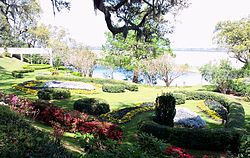 Orton Plantation Gardens overlooking the Cape Fear River
Orton Plantation Gardens overlooking the Cape Fear River
The Orton Plantation house is an example of Classical Revival and Greek Revival architecture. Originally a 1 1⁄2-story white brick building, a second floor was added to the house in 1840 along with four fluted Doric columns. Two wings were added to the house in 1904, thus making the home a prime example of antebellum architecture. A corbelled brick chimney is located on each side of the original section of the home.[2]
Similar to the house, Luola's Chapel is a white brick structure with four Doric columns. The chapel is surrounded by gardens and features a small steeple. A pavilion is located near the chapel.[5]
Orton Plantation Gardens contains 20 acres (81,000 m2) of lawns and formal gardens, as well as 60 acres (24 ha) of fountains, statues, forests, lagoons, old rice fields, and a family cemetery. The garden features tree-lined brick paths and rows of camellias, dogwoods, magnolias, crape-myrtles, annuals, and perennials. The front gates of the property are topped with cement eagles which lead to a dirt path driveway lined with large oak trees draped in Spanish moss that were planted in the 18th century.[3][5][9]
Popular culture
In 1983, American movie producer Frank Capra, Jr. searched for a location to film a scene for his movie Firestarter and chose Orton Plantation. Afterwards, Capra Jr. convinced movie producer Dino De Laurentiis to open a studio in nearby Wilmington. Laurentiis founded the De Laurentiis Entertainment Group which brought additional opportunities for movie and television filming at the Orton Plantation.[10][11]
Since 1983, Orton Plantation has been featured in 23 films and 34 television movies and series. Some of the movies that feature scenes from Orton Plantation include Lolita, Divine Secrets of the Ya-Ya Sisterhood, Hounddog, and A Walk to Remember. Television series that have filmed scenes at Orton Plantation include One Tree Hill, Dawson's Creek, Hart of Dixie and Matlock.[5][12]
See also
- List of plantations
- National Register of Historic Places listings in North Carolina
References
- ^ "National Register Information System". National Register of Historic Places. National Park Service. 2008-05-09. http://nrhp.focus.nps.gov/natreg/docs/All_Data.html.
- ^ a b c d e f "Orton Plantation". State Library of North Carolina. http://64.233.169.104/search?q=cache:VqZPiWw7fbgJ:statelibrary.dcr.state.nc.us/nc/ncsites/orton.htm+orton+plantation&hl=en&ct=clnk&cd=3&gl=us. Retrieved 2008-05-09.
- ^ a b c Lino, Kate. "Orton Plantation Gardens". North Brunswick Magazine. http://www.thenbm.com/show/orton.html. Retrieved 2008-05-09.
- ^ "Alfred Moore (1755–1810)". North Carolina History Project. http://www.northcarolinahistory.org/encyclopedia/146/entry. Retrieved 2008-05-09.
- ^ a b c d e f g h "History". Orton Plantation. http://www.ortongardens.com/history.shtml. Retrieved 2009-10-20.
- ^ Sprunt, James (1914). Chronicles of the Cape Fear River: Being Some Account of Historic Events. Edwards & Broughton Printing Company. pp. 42
- ^ "Brunswick Town State Historic Site". The Historical Marker Database. http://www.hmdb.org/Marker.asp?Marker=5535. Retrieved 2008-05-09.
- ^ Loewer, Peter (2007). Gardens of North Carolina: A Traveler's Guide. Stackpole Books. pp. 76. ISBN 0811733742
- ^ Prose, Francine (1993-03-07). "A Sojourn On Cape Fear". The New York Times. http://query.nytimes.com/gst/fullpage.html?res=9F0CE1D91339F934A35750C0A965958260&sec=&spon=&pagewanted=2. Retrieved 2008-05-09.
- ^ Waggoner, Martha (2007-12-20). "Studio Head Frank Capra Jr. Dies". Fox News Channel. http://www.foxnews.com/wires/2007Dec20/0,4670,ObitCapraJr,00.html. Retrieved 2008-05-09.[dead link]
- ^ Hotz, Amy (2005-05-09). "Released 25 years ago, 'Firestarter' changed the fate of Wilmington". The Star-News. http://www.starnewsonline.com/article/20090509/ARTICLES/905099969/1004?Title=Released-25-years-ago-Firestarter-changed-the-fate-of-Wilmington. Retrieved 2009-08-31.
- ^ Shaffer, Josh (2006-05-28). "Tales of an alligator relocator: As humans take over coastal swamps, an outdoorsman answers calls to remove reptiles.". The News & Observer. http://www.newsobserver.com/102/story/444581.html. Retrieved 2009-08-05.[dead link]
Further reading
- Orton Plantation, by H. Lacy Hunt, Jr., Doubleday, Page & Company, 1937, OCLC 244097467
- Orton Plantation, by The North Carolina Society of the Colonial Dames of America, 1938, OCLC 174142000
- The Story of Orton Plantation, by James Laurence Sprunt, Orton Plantation, 1958, OCLC 53993340
External links
U.S. National Register of Historic Places Topics Lists by states Alabama • Alaska • Arizona • Arkansas • California • Colorado • Connecticut • Delaware • Florida • Georgia • Hawaii • Idaho • Illinois • Indiana • Iowa • Kansas • Kentucky • Louisiana • Maine • Maryland • Massachusetts • Michigan • Minnesota • Mississippi • Missouri • Montana • Nebraska • Nevada • New Hampshire • New Jersey • New Mexico • New York • North Carolina • North Dakota • Ohio • Oklahoma • Oregon • Pennsylvania • Rhode Island • South Carolina • South Dakota • Tennessee • Texas • Utah • Vermont • Virginia • Washington • West Virginia • Wisconsin • WyomingLists by territories Lists by associated states Other Categories:- Antebellum architecture
- Houses completed in 1735
- American Civil War hospitals
- Botanical gardens in North Carolina
- Chapels in the United States
- Classical Revival architecture
- Film shooting locations
- Greek Revival architecture in North Carolina
- Historic house museums in North Carolina
- Open air museums in North Carolina
- Houses on the National Register of Historic Places in North Carolina
- Museums in Brunswick County, North Carolina
- Plantations in North Carolina
Wikimedia Foundation. 2010.

